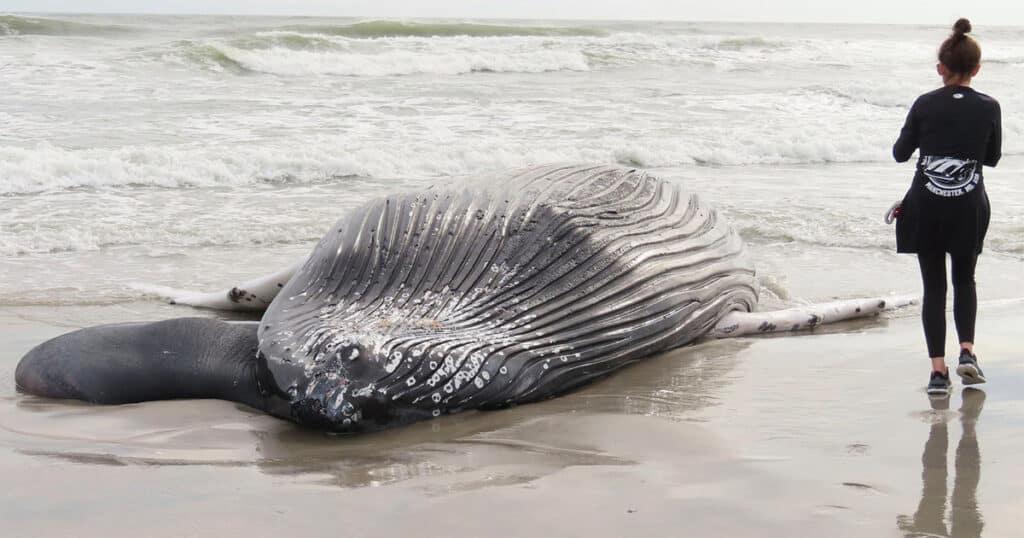
As Whales Wash Up Dead, Feds Push Forward With “Green” Energy
Recently, an unusual number of dead whales have washed up on the beaches off the East Coast, stretching from New York to Virginia. A total of 16 have been found washed up on these shores in just the last month alone. It is speculated that more dead whales are floating out in the open ocean eluding observation.
Although the Bureau of Ocean Energy Management (BOEM) recently issued a dozen authorizations for wind development firms to conduct “surveys” for offshore wind development – called Incidental Harassment Authorizations (IHA) – federal officials insist that there is “no evidence” linking these IHAs to the “recent large whale mortalities.” Amazingly, even though these surveys happened to take place in federal waters directly opposite from where the dead whales were found, there doesn’t seem to be any federal officials at BOEM raising any eyebrows over the matter.
The good news is a lot of people are upset and speaking out. In fact, so much so that elected officials have now gotten actively involved. The mayors of 30 New Jersey coastal towns have filed a petition with Gov. Murphy demanding a moratorium on offshore wind pre-construction activity until the cause of the whale deaths can be established. Three Congressmen, one from Maryland and two from New Jersey, have initiated a resolution which demands a full investigation of this situation by the Government Accountability Office and a halt to any further offshore wind preconstruction activity.
Congressman Jeff Van Drew (R. NJ) is the primary legislator leading the charge in the House. He is planning to hold a public hearing on March 16 at the Wildwood Convention Center in New Jersey where citizens can give their input on matters surrounding the recent whale deaths and explore potential solutions to solve it. Chief among the ideas being bandied about is a moratorium to halt further offshore wind development.
Of principle concern to many is the mapping of the ocean floor where the turbines will be placed. The preconstruction efforts authorized by the IHAs consist primarily of “sonar” mapping – a process that emits sonar blasts over the proposed wind development area in order to determine the optimum placement of wind towers and the miles of trenches need for the placement of electrical cables connecting the project to the onshore electrical grid. The acoustics of these sonar blasts are widely believed to interfere with the “echolocation” which Right Whales use to navigate their way in the ocean. Right Whales, for example, have very poor eyesight, and sound identification is critical to their feeding, breeding, and communicating.
Federal regulations define two types of “harassing” – Level A and Level B. For the IHAs in question, Level B is authorized by BOEM — which means activity “which has the potential to disturb a marine mammal … by causing disruption of behavioral patterns, including migration, breathing, nursing, breeding, feeding or sheltering…” In other words, the potential to interfere with just about everything involving the life of whales.
But here comes the kicker – and it involves the one caveat in the IHA relied on by BOEM to absolve it of culpability. The harassment authorized by Level B, it is sternly noted, “cannot have the potential to injure a marine mammal”.
Got that? Companies can do everything which has the potential to disturb whales, but they are not allowed to “injure” them.
“Potential to injure” is, unfortunately, not defined by the federal regulations.
So let’s look at an actual IHA, and see what it says. Does it contain “evidence” for these whale deaths?
An IHA was issued to Vineyard Wind in Massachusetts for the period from May 1, 2023 to April 30 2024 authorized a “take” – technical term for disturb – of whales for activity “incidental to pile driving” (that is to say, sonar mapping). The number of “takes” for North Atlantic Right Whales is established at 20. It further states that “taking by serious injury or death…is prohibited.”
Are you confused by now? You’re not alone. It appears the feds allow the developer to “take” 20 Right whales, by doing everything from “disturbing their behavioral pattern” to breathing, but “injuring” them is prohibited. Not only that, but the IHA actually anticipates an approved activity could kill a whale, because it continues by saying that if a developer “discovers a dead or injured marine mammal that was clearly caused by the IHA activity,” it must “immediately cease the activity.”
Well, the whales would be grateful for that – except for the dead ones, of course.
Let’s hope the attendees at the hearing called by Congressman Van Drew in Wildwood ask a lot of tough questions. BOEM and the wind developers appear to be rushing forward with their projects to “Save the Earth” and push “Green” energy at all costs – even if they must kick a few dead whales that get in the way.
Collister Johnson is a CFACT Senior Policy Advisor who was appointed by President George W. Bush as a member of the Overseas Private Investment Corporation .
This article was originally published by RealClearEnergy and made available via RealClearWire.



